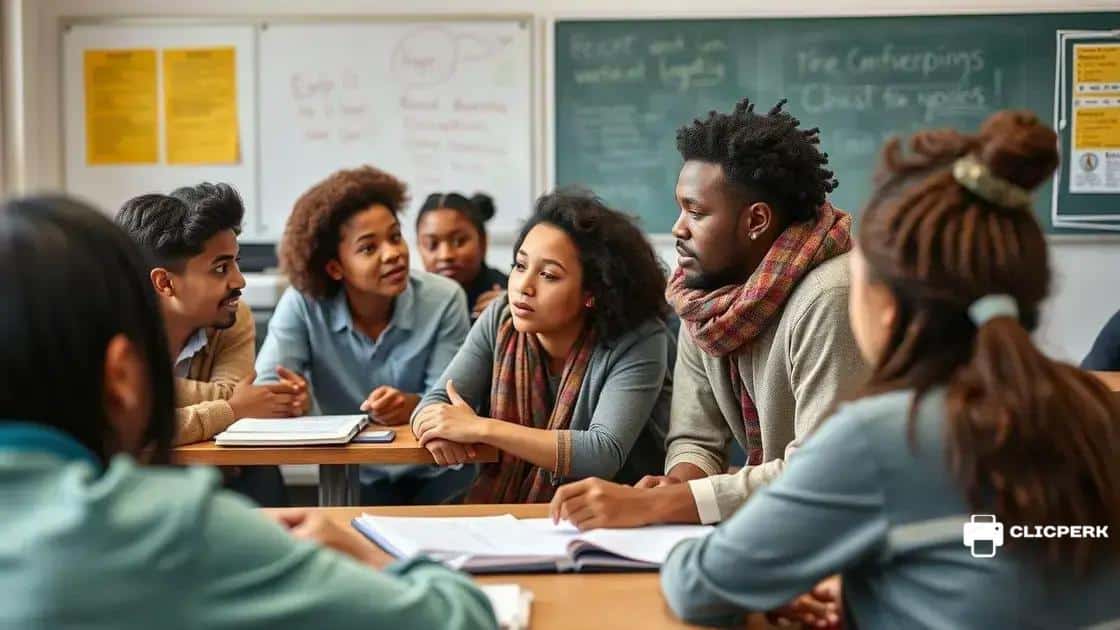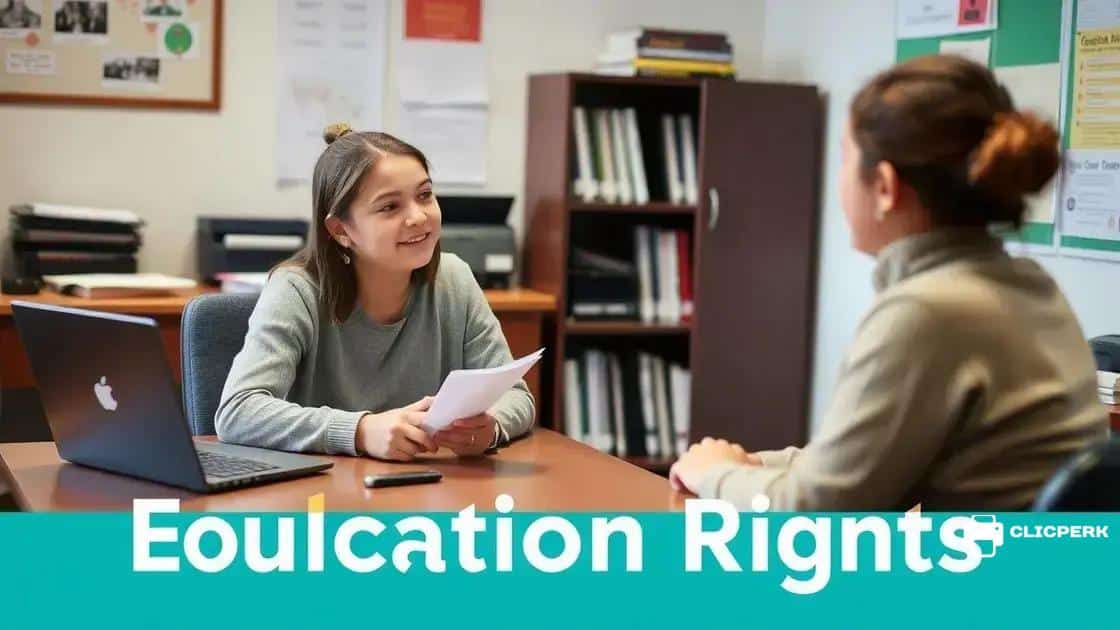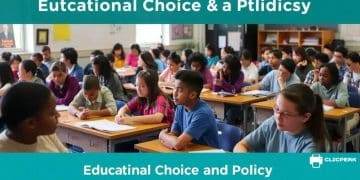Education rights legal challenges: understanding your options

Education rights legal challenges include discrimination, lack of accommodations, and unfair disciplinary actions, making advocacy essential for ensuring equal access and support for all students in the education system.
Education rights legal challenges can be daunting for students and families alike. Have you ever felt lost navigating the complexities of educational policies? In this article, we’ll unpack these challenges and offer clarity and solutions.
What are education rights?
Education rights are essential for every student. They ensure that all individuals have access to quality education and the support they need to thrive in academic settings. Understanding these rights is crucial as they help protect students from discrimination and give them the tools to succeed.
One key aspect of education rights is the right to equal opportunity. Students should not face barriers based on race, gender, disability, or any other factor. Federal laws protect these rights, making it essential for schools to accommodate all learners.
Types of Education Rights
Education rights encompass various areas that directly affect students and their learning environments. Some key categories include:
- Right to Free Education: Every child has the right to receive an education without charge.
- Right to Non-Discrimination: Students must be treated equally regardless of personal characteristics.
- Right to Participation: Students and parents should have a voice in educational decisions.
- Right to Special Education: Those with disabilities are entitled to tailored support and resources.
Being informed about your education rights helps empower students and their families. Schools are required to provide proper resources and fair treatment to all students. When these rights are violated, students can face serious consequences, including limited access to quality education and support. It is vital for parents and guardians to actively engage with school policies to ensure these rights are upheld.
Why Understanding Education Rights Matters
Knowing one’s education rights is not just about compliance. It also fosters a supportive learning environment where every student can reach their full potential. When families understand their rights, they can advocate effectively for their children. For example, if a school fails to accommodate a student with special needs, parents can seek legal recourse to ensure their child receives the necessary support.
This knowledge can create a ripple effect, promoting a culture of fairness and equity within schools. Parents and students alike should feel confident in navigating educational settings, ensuring that their voices are heard and respected. Additionally, when schools recognize and uphold these rights, it leads to better educational outcomes overall.
Common legal challenges in education
Students often encounter various challenges when it comes to their education rights. It’s important to understand these common legal challenges that can affect access to quality education. Recognizing these issues will empower students, parents, and educators to address them effectively.
Discrimination in Schools
One major challenge is discrimination. Students may face unfair treatment based on race, ethnicity, gender, or disability. Schools are required by law to provide an equal environment for all students. When discrimination occurs, it can lead to a hostile learning atmosphere and negatively impact students’ performance.
- Examples of discrimination: unequal discipline, biased grading, and limited access to advanced courses.
- Legal protections: Title IX and the Equal Education Opportunities Act protect students against discrimination.
Another pressing issue is insufficient special education services. Many students with disabilities are not receiving the resources and support mandated by law. This can hinder their learning and overall development. Parents must be proactive in advocating for the necessary services and accommodations.
Disciplinary Actions
Schools can sometimes impose harsh disciplinary actions that may be unjust. This can involve suspensions or expulsions without a fair hearing. Such practices can disproportionately affect certain groups of students and disrupt their education. Schools need to ensure that disciplinary measures are applied fairly and consistently.
- Key considerations: the right to a fair hearing, providing alternative solutions, and understanding the impact of suspensions on student success.
- Due process rights: students have the right to appeal disciplinary decisions.
Additionally, inadequate funding and resources can lead to poor educational conditions. Schools in low-income areas may struggle to provide safe facilities and quality materials. This affects students’ learning experiences and opportunities for success. Advocating for equitable funding is crucial in addressing this challenge.
How to advocate for your education rights

Advocating for your education rights is crucial for ensuring that you receive the support and resources you deserve. Knowing how to effectively voice your concerns can make a significant difference in your educational experience.
Understand Your Rights
The first step in advocacy is understanding what your rights are. Familiarize yourself with laws like the Individuals with Disabilities Education Act (IDEA) and Title IX, which protect students from discrimination and ensure access to necessary resources. Being knowledgeable empowers students to stand up for themselves and others.
- Research your rights: Read up on the laws that affect you.
- Know the policies: Understand your school’s rules and regulations.
- Document everything: Keep records of any incidents or issues you face.
Engaging with teachers and school administration is an important part of the advocacy process. It is vital to express your needs clearly and persistently. Building a positive relationship with educators can help facilitate open communication. When you approach them, be respectful and direct about your concerns.
Get Involved with Parent and Student Groups
Another effective way to advocate for your education rights is by joining local parent and student advocacy groups. These organizations work to promote educational equity and can provide a collective voice for those facing similar challenges. Joining a group can also connect you with resources and support that may not be available through schools.
- Share your story: Personal experiences can highlight important issues.
- Participate in meetings: Attend discussions where education rights are addressed.
- Support each other: Encourage fellow members to advocate as well.
Lastly, don’t hesitate to seek legal advice if you’re facing significant barriers. Lawyers who specialize in education law can offer valuable insights and help navigate complex situations. They can also assist in filing complaints or taking necessary actions if rights are being violated.
Resources for legal support
Accessing legal resources is essential for understanding and advocating for your education rights. Knowing where to find support can empower students and their families in navigating challenges effectively.
Legal Aid Organizations
One important resource is local legal aid organizations. These groups often provide free or low-cost legal services to individuals facing educational issues. They specialize in helping with rights violations and can assist in understanding your options.
- Find a legal aid office: Search online for legal aid services in your area.
- Eligibility requirements: Check the guidelines to see if you qualify for their services.
- Consultations: Many offer initial consultations to discuss your situation without any cost.
Another significant option is contacting advocacy groups focused on education. These organizations work tirelessly to promote education rights and provide resources to those in need. They can offer guidance and sometimes even legal representation.
Online Resources
In the digital age, numerous online platforms offer valuable information regarding your education rights. Official sites such as the U.S. Department of Education provide resources and guidelines that can clarify legal protections available to students. These resources include:
- Guidance documents: Detailed explanations of federal regulations.
- FAQs: Answers to common questions regarding education rights.
- Hotlines: Support services that you can call for immediate assistance.
Additionally, consider forums and websites that further discuss education rights, where you can read stories and engage with others who have faced similar challenges. These platforms can help build knowledge and community around education rights advocacy.
Furthermore, resource books and guides available in libraries can be invaluable. Many of these books offer insights into education law and personal rights, usually written in accessible language. Utilizing these materials can enhance your understanding and ability to advocate for yourself and others.
Real-life case studies and outcomes
Real-life case studies can shed light on the importance of understanding and advocating for education rights. Learning from these cases helps students, parents, and educators see the impact of advocacy and how challenges can be addressed.
Case Study 1: Disability Rights in School
One notable case involved a student with learning disabilities who was not provided the necessary accommodations. The parents worked with an education advocate to ensure their child received a proper Individualized Education Plan (IEP). This case highlighted the importance of communicating with school officials and knowing one’s rights.
- Outcome: After mediation sessions, the school developed a comprehensive IEP.
- Impact: The student improved academically and felt more supported in the classroom.
- Lesson learned: Understanding legal rights can lead to better educational outcomes.
This situation illustrates how advocacy can lead to meaningful changes in a student’s education. Proper accommodations can greatly enhance a student’s ability to learn and engage with their peers.
Case Study 2: Title IX and Gender Equality
Another important case involved a high school girl who experienced discrimination in sports. She was not allowed to try out for the boys’ team due to her gender. With support from a local advocacy group, she challenged this decision under Title IX, which prohibits gender discrimination in education.
- Outcome: The school district revised its policies on sports participation.
- Impact: The girl was allowed to try out for the team and became an advocate for gender equality.
- Lesson learned: Legal support can effectively challenge unfair practices.
This case underscores the importance of standing up against discrimination and how collective efforts can bring about significant change within educational institutions. Advocacy not only empowers individuals but can also set precedents for future students.
These real-life situations demonstrate that while challenges exist, there are paths to resolution through understanding rights and seeking support. Each success story reflects a commitment to education rights and can inspire others to take action.
Advocating for your education rights is vital for achieving equality and fairness in the learning environment. By understanding your rights, utilizing available resources, and encouraging others, you can make a significant impact. Real-life cases illustrate how determination and knowledge lead to positive change. Every student’s voice matters, and together, we can create a more just educational system.
FAQ – Frequently Asked Questions about Education Rights Advocacy
What are education rights?
Education rights ensure that all students have access to quality education without discrimination or barriers.
How can I advocate for my education rights?
You can advocate for your rights by understanding them, communicating with school officials, and seeking support from legal aid organizations.
What resources are available for legal support?
There are legal aid organizations, advocacy groups, and online resources that provide information and assistance regarding education rights.
Why are real-life case studies important?
Real-life case studies demonstrate the impact of advocacy efforts and can inspire others to take action when facing education rights challenges.





